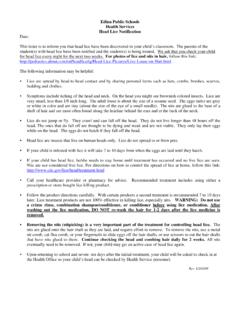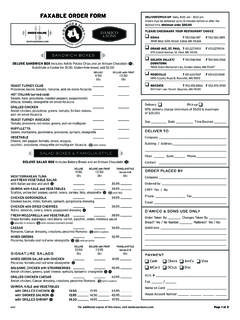Transcription of Progression in Mapping - Digimap
1 D10877_primary Aug 2016 Progression in Mapping Paula Owens Geography teaching resource Primary D10877_primary Aug 2016 D10877_primary Aug 2016 Digimap for Schools resources: Progression map to show how you might develop Mapping skills in Primary Using and interpreting Position and orientation Drawing Symbols Perspective & scale Digital map making Year 1 and 2 I can find information on aerial photographs.
2 I know that maps give information about the world (where and what?). I can follow a route on a prepared map. I can recognise simple features on maps such as buildings, roads and fields. I recognise that maps need a title. I can use maps to talk about everyday life for example, where I live, journey to school, where places are in a locality. I can begin explaining why places are where they are. I am beginning to use directional vocabulary. I can say which direction N,S,E,W is for example, using a compass in the playground. I know which direction N is on an Ordnance Survey map. I can draw a simple map (real or imaginary place) for example, freehand maps of gardens, watery places, route maps, places in stories. I can use symbols on maps (own and class agreed symbols). I know that symbols mean something on maps. I can find a given Ordnance Survey symbol on a map with support.
3 I am beginning to realise why maps need a key. I can look down on objects and make a plan for example, on desk, high window to playground. I can draw objects to scale (for example, on table or tray using squared paper 1:1 first, then 1:2 and so on). I can use large scale, vertical aerial photographs. I know that when you zoom in you see a smaller area in more detail. I can find places using a postcode or simple name search. I can add simple information to maps for example, labels and markers. I can draw around simple shapes and explain what they are on the map for example, houses. I can use the measuring tool with support to show distance for example, my house to school, to the shops. I can zoom in and out of a map. I can draw a simple route. I can highlight areas. I can add an image to a map. Work confidently with: Large scale street maps and large scale Ordnance Survey maps (1:1250.)
4 1:2500), aerial photographs, games with maps and globes. Have experience: of a range of different maps for example, tourist brochure, paper maps, storybook maps, Ordnance Survey digital maps at different scales and globes and atlases. Introduce: simple grids, four cardinal points, basic digital Mapping tools, zoom function of digital maps. Context: focus on the local scale - home, school, neighbourhood, everyday lives (their own and others), work in the school grounds; global scale world maps, globes and through story. Suggested Digimap for Schools Activities (* Ks1-2) Letter to our school Where do I live? How can we get to Grandma s safely? What s the quickest way to school? My geography glasses Who goes to school by boat?* Where does our milk come from?* Where do I go in a week?* Capital Stops* My Dream Island* The Magic Telescope* D10877_primary Aug 2016 Using and interpreting Position and orientation Drawing Symbols Perspective & scale Digital map making Year 3 and 4 I can use atlases, maps and globes.
5 I can use large scale maps outside. I can use maps at more than one scale. I can make and use simple route maps. I can locate photos of features on maps. I can use oblique and aerial views. I can recognise some patterns on maps and begin to explain what they show. I can give maps a title to show their purpose. I can use thematic maps. I can explain what places are like using maps at a local scale. I recognise that contours show height and slope. I can use simple grids. I can give direction instructions up to 8 cardinal points. I can use 4-figure coordinates to locate features. I know that 6figure Grid References can help you find a place more accurately than 4- figure coordinates. I can make a map of a short route with features in correct order. I can make a map of small area with features in correct places. I can use plan views regularly.
6 I can give maps a key with standard symbols. I can use some Ordnance Survey style symbols. I can use maps and aerial views to help me talk about for example, views from high places I can make a simple scale plan of room with whole numbers for example, 1 = 1 square tile on the floor moving onto 1cm2 = 1m2. I can use the scale bar to estimate distance. I can use the scale bar to calculate some distances. I can relate measurement on maps to outdoors (using paces or tape). I can use the zoom function to locate places. I can use the zoom function to explore places at different scales. I can add a range of annotation labels and text to help me explain features and places. I can highlight an area on a map and measure it using the Area Measurement Tool. I can use grid references in the search function I can use the grid reference tool to record a location.
7 I can highlight areas within a given radius. I can add photographs to specific locations. Work confidently with: Large scale street maps and large scale Ordnance Survey maps (1:1250. 1:2500), aerial photographs, oblique and bird s eye views, games with maps and globes, Ordnance Survey maps 1:1250, 1:2500 and 1:10 000, 4-figure coordinates. Have experience: of a range of different maps for example, tourist brochure, paper and digital maps, storybook maps, atlases, Ordnance Survey paper and digital maps at different scales, 6-figure coordinates. Introduce: what 6-figure Grid References mean, 8 cardinal points, greater independence in using digital Mapping tools. Context: a range of places in the wider locality and in contrasting localities, fieldwork in the wider locality. Suggested Digimap for Schools Activities Treasure Hunt Picture Detectives Artful Maps Patterns of land use Flying High: White Tailed Eagles Teifi Travels A Taste of Scotland Landscape Fingerprints D10877_primary Aug 2016 EDINA at University of Edinburgh 2016 This work is licensed under a Creative Commons Attribution-Non Commercial License Using and interpreting Position and orientation Drawing Symbols Perspective & scale Digital map making More Able Y6 Year 5 and 6 I can relate maps to each other and to vertical aerial photographs.
8 I can follow routes on maps saying what is seen. I can use index and contents page of atlas. I can use thematic maps for specific purposes. I know that purpose, scale, symbols and style are related. I can appreciate different map projections. I can interpret distribution maps and use thematic maps for information I can follow a route on 1:50 000 Ordnance Survey map; I can describe and interpret relief features. I can use 4 and 6-figure coordinates to locate features. I can give directions and instructions to 8 cardinal points. I can align a map with a route. I can use latitude and longitude in an atlas or globe. I can make sketch maps of an area using symbols and key. I can make a plan for example, garden, play park; with scale. I can design maps from descriptions. I can draw thematic maps for example, local open spaces.
9 I can draw scale plans. I can use agreed and Ordnance Survey symbols. I appreciate maps cannot show everything. I can use standard symbols I know 1 symbols and atlas symbols. I can use a range of viewpoints up to satellite. I can use models and maps to talk about contours and slope. I can use a scale bar on all maps. I can use a linear scale to measure rivers. I can describe height and slope using maps, fieldwork and photographs. I can read and compare map scales. I can draw measured plans for example, from field data. I can find 6-figure grid references and check using the Grid Reference Tool. I can combine area and point markers to illustrate a theme. I can use maps at different scales to illustrate a story or issue I can use maps to research factual information about locations and features. I can use linear and area measuring tools accurately.
10 Work confidently with: Large scale street maps and large scale Ordnance Survey maps (1:1250. 1:2500); aerial photographs, oblique and bird s eye views, games with maps and globes, Ordnance Survey maps 1:1250, 1:2500,1:10 000, 1:25 000. 1:50 000 4 and 6-figure coordinates. Have experience: of a range of different maps for example, tourist brochure, paper and digital maps, storybook maps, atlases, Ordnance Survey paper and digital maps at different scales, 6-figure coordinates Introduce: what 6 figure Grid References mean and how to calculate them. Context: a range of places at different scales and with different themes, fieldwork in the wider and distant locality. Suggested Digimap for Schools Activities Fantasy Maps Weather Warning! Coastal Mysteries Landscape Poetry Lighthouse for Sale My Top Tourism Trail It s a Rubbish Footprint!







